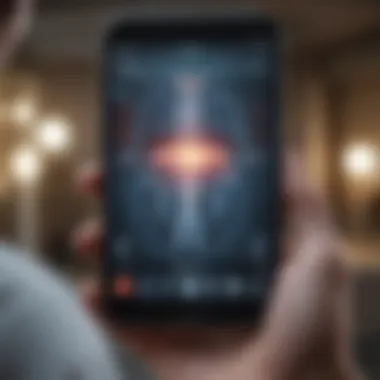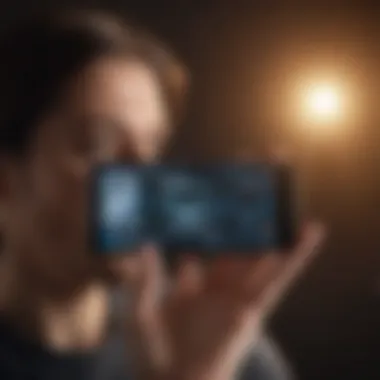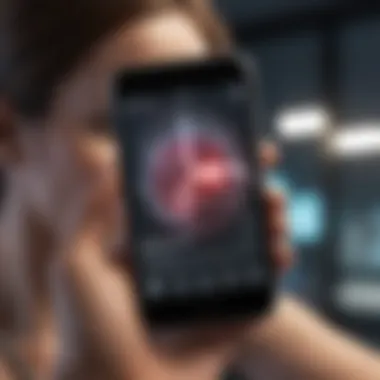Understanding M-Health: Concepts and Challenges


Intro
Mobile health, often referred to as m-health, is rapidly reshaping the landscape of healthcare delivery. With the advent of smart devices, applications, and digital innovations, healthcare is becoming more accessible than ever. M-health involves the use of mobile technologies to support health services and information. It encompasses a variety of applications, ranging from monitoring chronic conditions to enhancing patient engagement.
This article intends to provide a comprehensive examination of m-health, its implications, and future potential within the healthcare system. By exploring concepts, identifying challenges, and suggesting future directions, it aims to offer a detailed insight into this significant domain. Readers will gain an understanding of how m-health can advance patient care and tackle existing challenges in the healthcare sector.
Defining M-Health
Understanding the concept of m-health is crucial in the context of modern healthcare. M-health, which stands for mobile health, hinges on the use of mobile devices to facilitate health care delivery. This integration not only amplifies patient care but also supports healthcare professionals in managing and monitoring health data. By defining m-health clearly, we pave the way for a nuanced discussion on its significance, benefits, and the myriad of challenges it faces.
Clear Definition and Scope
M-health is best defined as the utilization of mobile technologies, including smartphones and tablets, to support various health services. This encompasses a wide range of functionalities such as health monitoring, patient education, data management, and communication between health providers and patients.
The scope of m-health extends beyond mere convenience. It includes features like remote patient monitoring, health tracking applications, and even mobile platforms for telemedicine. It has the potential to revolutionize the way healthcare is approached, making it accessible, affordable, and efficient.
Several key aspects characterize m-health:
- Accessibility: With the rise of mobile technology, healthcare can reach individuals in remote or underserved areas.
- Real-Time Data Sharing: Immediate access to real-time health data can significantly enhance patient management and response times.
- Patient Empowerment: By engaging patients in self-monitoring and education, m-health encourages personal accountability in health management.
These features not only highlight the importance of m-health but also stress the need for proper definitions and frameworks to maximize potential benefits in health outcomes.
Historical Context of M-Health
The evolution of m-health can be traced back to the burgeoning field of telecommunications. In the late 1990s, the first m-health applications emerged, primarily focusing on SMS-based health messages. These applications aimed to provide essential health information and reminders for patients managing chronic conditions. As technology advanced, so did the functionalities of mobile health applications.
By the 2000s, the advent of smartphones transformed m-health into a more interactive and engaging platform. More sophisticated applications began to flourish, offering advanced monitoring features and integrating health databases. Notable milestones include:
- Introduction of Health Apps: Several fitness and health monitoring applications became popular, allowing users to track their exercise, diet, and overall wellness.
- Policy Developments: Governments and health organizations began recognizing the value of m-health, leading to investments in technology and infrastructures, such as mobile clinics in rural areas to bridge the healthcare gap.
- Research and Studies: Academic institutions and healthcare organizations initiated numerous research projects to evaluate the effectiveness and reliability of m-health solutions.
Today, m-health serves as a vital component in global health strategies. The constant innovation in mobile technology continues to reshape its landscape and expand its applications. With the growing emphasis on patient-centered care, m-health is poised to play an even more substantial role in the future of healthcare.
Technological Framework
The Technological Framework is a cornerstone of m-health, as it embodies the tools, systems, and protocols that define how mobile health operates. The integration of mobile technology into healthcare delivery relies heavily on this framework. Understanding the components of this framework is crucial for grasping better how m-health can enhance healthcare access and optimize patient outcomes.
Mobile Devices and Applications


Mobile devices and applications form the first layer of the technological landscape in m-health. Smartphones and tablets have evolved into powerful tools for health management. They enable patients to monitor their health, access medical information, and communicate with healthcare providers instantly. These devices can run numerous applications tailored to specific health needs, from medication reminders to fitness tracking.
Health applications can be broadly categorized into several types:
- Patient Monitoring Apps: These allow real-time tracking of health metrics like heart rate or blood glucose levels.
- Telemedicine Apps: They facilitate communication between patients and doctors, enabling virtual consultations.
- Wellness and Fitness Apps: These applications focus on lifestyle changes, promoting physical activity, or healthy eating.
The importance of user-centered design in these applications cannot be overstated. A well-designed application enhances user engagement and adherence. Customization Features like reminders, alerts, and progress tracking motivate individuals to take active roles in their health management. This high level of engagement fosters a sense of control, ultimately leading to better health outcomes.
Data Transmission and Security
As part of the technological framework, the transmission of patient data raises significant challengs and opportunities. The vast amount of data generated through m-health applications requires robust and secure transmission mechanisms to protect sensitive information.
Effective data transmission depends on multiple factors:
- Encryption: Encrypting data during transmission prevents unauthorized access, ensuring patient confidentiality.
- Secure Networks: Utilizing secure networks and protocols, such as HTTPS, safeguards data from potential breaches.
- Data Integrity: It is vital to ensure that the data collected remains unaltered during transmission. Any discrepancy could lead to improper treatment decisions.
"Advanced security measures are not only a legal requirement but also a fundamental pillar for building trust with users in m-health solutions."
The balance between ease of access and stringent security measures presents an ongoing tension for m-health developers. The rise of cybersecurity threats requires continuous revisions to security protocols. It is essential for stakeholders to remain informed about new vulnerabilities and invest in protective infrastructure accordingly.
Ultimately, the interplay between mobile devices, applications, and secure data transmission shapes the m-health landscape. By leveraging these technologies effectively, healthcare providers can offer innovative and responsive care to their patients.
Applications of M-Health
The applications of m-health represent a central focus of this article, as they illustrate how mobile technology can enhance health care delivery. M-health is not just a trend; it embodies the future of health management. Its applications range from patient monitoring to comprehensive health tracking. Below, we explore three key areas where m-health is making significant strides.
Patient Monitoring
Patient monitoring through mobile health apps allows healthcare providers to keep track of their patients' health metrics in real-time. This capability promotes timely interventions and improves treatment outcomes. Using devices like smartwatches or mobile apps, patients can continuously share data related to vital signs such as heart rate or blood sugar levels. It empowers both patients and caregivers, fostering an approach where individuals take ownership of their health data.
For instance, individuals with chronic conditions like diabetes benefit from constant monitoring, enabling quick adjustments to treatment plans. Without the need for frequent hospital visits, the quality of life improves greatly while reducing costs. This shift towards remote patient monitoring is transforming care delivery.
Telemedicine Integration
Telemedicine, an integral component of m-health, enhances accessibility to healthcare services. Patients can consult their healthcare providers through video calls or chat functions without needing to travel. This is crucial, particularly for individuals residing in remote or underserved areas. Telemedicine reduces barriers, improving health equity.
Additionally, during public health crises, telemedicine has proven essential. It allows healthcare providers to offer care while minimizing exposure to infections. However, it is important to ensure that these services are secure and compliant with regulations. The potential for integrating telemedicine with other applications like EHRs (Electronic Health Records) could further streamline patient data access and management.
Health Tracking and Management Apps


Health tracking and management applications serve as personal health assistants. Many individuals use apps to monitor their diet, exercise routines, and medication schedules. These tools collect data but also provide insights that help users make informed decisions. Popular applications like MyFitnessPal or Fitbit not only track but visualize health progress.
These apps promote self-management, essential for chronic disease prevention and health improvement. Studying usage patterns can also provide valuable data for health researchers. This type of data collection may lead to better health strategies at a population level. Moreover, many apps offer features that connect users with communities, fostering support among peers.
Ultimately, the applications of m-health not only reshape patient care but also redefine the patient experience by prioritizing accessibility and engagement.
In summary, the applications of m-health significantly enhance medical practices, leading to improved outcomes in patient care. This transformation highlights the essential role of technology in modern health solutions. As these applications evolve, they hold the potential to further bridge gaps in health care accessibility and efficiency.
Benefits of M-Health
The Benefits of M-Health are multifaceted and can significantly reshape the healthcare landscape. Mobile health technologies hold promise for improving patient outcomes, reducing costs, and enhancing healthcare delivery. M-Health applications range from simple health tracking to complex monitoring systems. Understanding these benefits is crucial for stakeholders, including patients, healthcare providers, and policymakers.
Enhanced Patient Engagement
One of the primary advantages of M-Health is its ability to foster enhanced patient engagement. With mobile apps, patients can access their health information, receive reminders for medication, and engage in their care more actively. This increased accessibility helps patients to become more empowered, leading to better adherence to treatment plans. Studies show that when patients track their symptoms, they are more likely to communicate effectively with their healthcare providers. Moreover, interactive features in apps can motivate patients as they can see their progress in real-time.
Patients not only receive feedback but can also educate themselves about their conditions, thus enabling more informed decisions regarding their health. Furthermore, M-Health tools can improve follow-up rates with telemedicine options, making it easier for patients to sustain ongoing communication with their doctors.
Cost-Effective Health Care Solutions
Cost-effectiveness is a critical factor in any healthcare strategy. M-Health can significantly lower the costs associated with traditional healthcare settings. By reducing the need for in-person visits, mobile health applications decrease transportation costs for patients and variable costs for healthcare facilities. Telemedicine, for instance, allows for remote consultations, which can cut down expenses related to overhead and resource management. This transition leads to more efficient use of healthcare funds, potentially alleviating the financial pressure on both providers and patients.
According to recent studies, organizations that have implemented M-Health solutions have reported a measurable decrease in operational costs while simultaneously improving patient satisfaction. Health systems can strategically allocate resources, which is vital in underfunded environments.
Efficient Data Collection and Management
Efficient data collection and management are essential for any modern healthcare system. M-Health technologies facilitate real-time data gathering, enabling healthcare providers to monitor patient conditions closely and analyze trends over time. With the help of wearable devices, clinical staff can access vital statistics promptly and make immediate adjustments to treatment plans.
Moreover, comprehensive databases from M-Health applications can provide valuable insights during research studies or for public health monitoring. Aggregated data enables better planning and facilitates targeted interventions in public health strategies. This refined capability for data management reduces instances of errors and enhances the overall quality of care.
In summary, M-Health holds numerous benefits, including improved patient engagement, cost-effective solutions, and efficient data collection and management. As healthcare continues to evolve, it becomes increasingly essential to harness these tools appropriately.
"M-Health technologies could change the fabric of healthcare delivery, providing not just services but also engagement and cost containment."
Understanding these advantages can help stakeholders make informed decisions regarding the adoption of M-Health tools in their practices.
Challenges Facing M-Health
M-Health faces several challenges that can hinder its effective adoption and functionality. Understanding these challenges is crucial for stakeholders, including policymakers, technologists, and healthcare providers, to develop supportive strategies. As m-health continues to rapidly evolve, it becomes essential to address these key issues to realize its full potential.


Privacy and Security Concerns
The rise of m-health is accompanied by significant privacy and security concerns. Mobile devices collect vast amounts of sensitive health data, and the potential for breaches poses a serious risk. Data breaches can lead to identity theft and unauthorized usage of personal health information. Therefore, developers of m-health applications must prioritize security measures, such as encryption and secure data transmission protocols.
Moreover, users often lack awareness about the privacy policies of the applications they utilize. It is essential to educate patients and providers on how to safeguard their data while using mobile health tools. The use of strong passwords and security features like two-factor authentication can help enhance data protection. Moreover, ongoing discussions about data ownership are critical. Who ultimately owns the data generated from m-health apps? Clarifying ownership can help establish trust and encourage more individuals to engage with m-health technologies.
Regulatory and Compliance Issues
Navigating the regulatory landscape poses another challenge for m-health. Different countries have different regulations regarding health data that mobile applications must comply with. In the United States, for instance, app developers must be aware of the Health Insurance Portability and Accountability Act (HIPAA), which governs data privacy and security. In contrast, the European Union's General Data Protection Regulation (GDPR) emphasizes data protection and personal privacy.
The lack of consistent regulatory guidelines can create confusion and stifle innovation. Developers may hesitate to enter the m-health market due to fears of non-compliance or legal ramifications. It is therefore vital for regulatory bodies to create clear, consistent frameworks that promote innovation while ensuring the protection of patient data. Collaborative efforts, involving stakeholders from the medical, technological, and legal fields, could help facilitate this process.
Technological Barriers
While technology has propelled m-health forward, certain barriers remain. One significant barrier is the digital divide, which refers to the gap between individuals with access to digital technologies and those without. For instance, low-income populations or underdeveloped regions may lack access to smartphones or reliable internet. Therefore, m-health solutions may not reach those who could benefit the most.
Additionally, interoperability is a crucial issue in m-health. Many applications operate in silos, meaning that they do not work well with each other or existing health systems. This limits the potential for comprehensive patient data analysis, which is vital for informed decisions and better health outcomes. Solutions like standardized data formats and APIs are necessary to implement seamless communication between different systems and applications.
In summary, while m-health offers promising solutions for healthcare delivery, addressing the challenges of privacy, regulation, and technology is essential for maximizing its impact. Stakeholders must prioritize these areas to foster an environment where m-health can thrive.
The Future of M-Health
The future of m-health represents an evolving landscape that holds significant potential for transforming healthcare delivery and management. This concept expands far beyond its current applications, offering a wealth of opportunities for technological innovation, improved patient outcomes, and enhanced public health strategies. It is critical to understand not only what advancements are on the horizon but also how they may reshape existing healthcare systems and practices.
Innovations in Mobile Technology
Mobile technology continues to lead the charge in the future of m-health. Innovations such as advanced sensors, machine learning, and artificial intelligence are becoming increasingly integral to mobile health applications. Wearable devices, like smartwatches and fitness trackers, are now capable of continuously monitoring vital signs and other health metrics. This real-time data can be invaluable for patients with chronic conditions, providing timely insights into their health status.
Furthermore, mobile applications are leveraging artificial intelligence to offer personalized health recommendations. These intelligent systems adjust the suggested interventions based on user data, increasing the relevance and effectiveness of health advice. Cloud computing accelerates data storage and accessibility. This leads to seamless integration across services, which is important for unified health records.
Potential Impact on Health Systems
The implications of m-health on health systems are profound. As m-health technology evolves, it promises to create a more decentralized and patient-centered approach to healthcare. This shift can relieve some burden from overcrowded hospitals and clinics by allowing patients to manage their conditions at home, leading to more efficient use of resources.
Moreover, m-health can significantly improve care coordination among providers. Digital tools enable better communication between specialists, general practitioners, and other healthcare professionals, creating a comprehensive view of a patient’s health history. This connectivity helps reduce medical errors and enhance treatment outcomes.
However, the transition to m-health systems also introduces challenges related to infrastructure, training, and integration with existing healthcare frameworks. Hence, system planners and policymakers must consider these aspects thoroughly.
Global Trends and Research Opportunities
The global landscape for m-health is also shifting. Emerging markets are witnessing rapid growth in mobile technology, indicating a fertile ground for exploring innovative m-health solutions. Research opportunities abound in understanding how different demographics interact with m-health platforms, especially in regions where mobile technology adoption is still developing.
Equally, the rise of telemedicine and remote monitoring creates pathways for clinical trials and research that were previously infeasible. Insights gained from new data pools could improve healthcare on a global scale. Engaging with multidisciplinary teams, combining insights from health informatics, epidemiology, and data science, will be crucial for advancing future m-health capabilities.
M-health can dramatically enhance access to healthcare, especially in regions where traditional amenities are scarce. The opportunity to bridge gaps and improve health delivery is significant.



